
Written by: Zahrah Mazhar
Posted on: June 10, 2016 | 
Cafe Kessabine
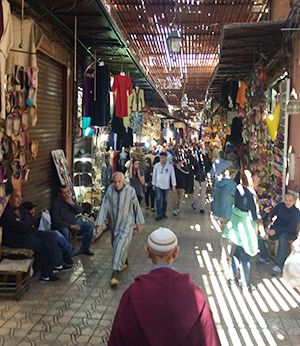
To clarify, when most people say that they’ve been to Marrakech, it is safe to assume that they’ve actually seen very little of the entire city and spent most of their time in the Medina and its surrounding areas—which make up the old district. The walled part of the city with its narrow and maze-like lanes and winding souks appears untouched by time when you observe only the aesthetics, but stand still at a spot for a mere 60 seconds and you’ll find yourself in a tourist trap of some sort—a reminder that you are very much in the present-day Marrakech where some of the locals will unabashedly try to take advantage of your visible lack of direction. Just like in the old district of the city, it can be hard to stay on track when talking about Marrakech, so I’m going to retrace my steps to the start of the trip to our four-hour comfortable train journey from Casablanca (most main flights arrive in the city made famous by the Humphrey Bogart movie).
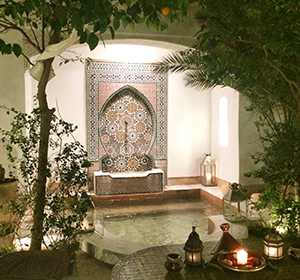
Passing through the salmon-coloured walls, owing to which the city is often referred to as the “Red City” or “Rose City,” we reached our riad—a serene sanctuary, to say without any exaggeration—in Marrakech with the help of the taxi driver booked ahead. Riads (meaning “gardens”) are the old houses of Marrakech, typically featuring five to six rooms, a courtyard, and a garden, which have now been transformed into chic bed and breakfast accommodations. Tucked away in a narrow alley, the riad is devoid of any sound from the commotion outside, making it an ideal escape at the end of the day. Our residence, Riad Karmela, was easily one of the best parts of our trip, where the service was exceptional and the Moroccan tea under the orange trees in the evenings was memorable.
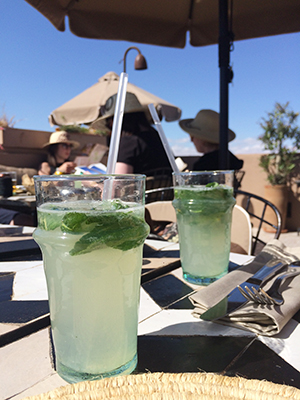
Once you make your way out of the riad’s alley into what could be considered the main roads, be prepared for a sensory overload. Sounds from the donkey carts, cars, motorbikes, people, fruit vendors, and horse carriages carry over the smell of the freshly baked bread and raw meat wafting out of the tiny shops as you try to make your way to the souks. Pro tip: don’t respond to anyone who tries to tell you where to go; either look for the sign without appearing fazed by all the sounds and people, or ask a shopkeeper. In all fairness, for every con artist lurking in the corner, there’s a helpful Moroccan who’ll go out of his way to guide you.
Regardless of the route you choose, you’re going to pass by hundreds of shops of jewellery, ceramic tagines and plates, shoes, spices, leather goods, tea and herb shops, and much more. Stop, haggle, and buy. Don’t be shy when it comes to bargaining; if the shopkeeper says 800 dirhams, start from 100. Eventually, you’ll both reach a price where you feel you haven’t been duped and the seller looks content with his “no profit” sale.
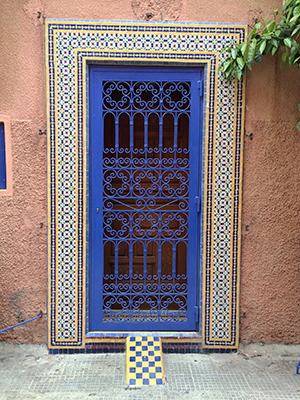
The zigzag lanes are lined with more passageways and old houses, featuring the most beautiful doors and zelij (tilework). As you stop to admire an antique door with carefully crafted arabesque patterns, you’ll hear snippets of conversations in French from the passers-by while the man at the shop nearby plays an African drum—that’s the spirit of Marrakech, where Arabian, European, and African influences converge. You’ll find this contrast in the architecture, the dressing, and even the food and cafés. The Berber North African dishes tajine and couscous are widely popular and served in all the eateries, but sandwiches and pastas are just as easily found. Almost all the restaurants have rooftop terraces—an essential feature of Marrakech structures—and while the food you’re eating might taste familiar to Arabic mezze with a hint of African spices, the ambience is essentially European. In a city of bright colours, the décor of the cafés is kept minimal with white and beige and a touch of greenery, while French music plays in the background.
For the extremely animated and meaty dining experience, head to the veritable open-air theatre—Place Jamaâ El Fna. The square, which you will hear/read about right from the planning stage of your trip, is where all the souks lead to, it’s where the snake charmers settle beside the Berber henna artists, and it’s where the crowds and the beats of the drums only get bigger and louder as the night goes on.
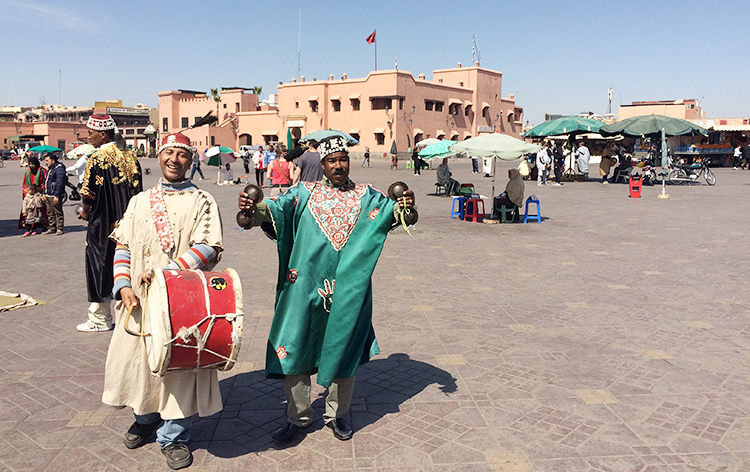
Take a seat at one of the many busy food vendors to dine on freshly prepared grilled meat and fish, and make sure to buy fresh orange juice from the stalls—it’s just what you need to refresh yourself. If you’d rather take in the sights and sounds from a distance, then go to the terraces of Café de France or Le Grand Balcon Café Glacier; both offer minty Moroccan tea and spectacular views of the Place Jamaâ El Fna and Koutoubia Mosque—a perfect combo to cap off a Marrakech evening.
Coming Soon: Marrakech Part II: A Walk through the Moorish and French Eras
Click to view picture gallery
You may also like: